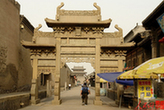All over the old town there are unique buildings inspired by and in harmony with Nature. Cultural relics, both tangible and intangible, also abound. In the vicinity of Lijiang there are the Shuhe Folk Residence and Baisha Folk Residence Complex, as well as cultural sites like the Five Phoenix Tower in the Fuguo Temple, the Great Treasure Palace and the Glazed Hall.
b. Cultural Heritage
Music
Almost all Lijiang counties have their own ensembles of the traditional music, among which the Baihua and Dayan Troupe are the best known. The musicians of the traditional music are mostly advanced in age and experienced in both music and story telling. They have received the special attention of the government as carriers of the ancient culture of the Naxi people.
The most famous musical piece is the time-honored Baisha Music Suite combining singing, dancing and instrumental music, also known asBieshixieli, or Beishixili. Other forms of music include the Dongjing (Taoist Scripture) Music that originated among the Han people and maintains the rhythms and tunes of ci and qu, lost forms of classical verse from central China. Various kinds of dance music are also popular in the Lijiang area.
Murals
The renowned murals of Lijiang are to be found in the town, and the 15 temples in the surrounding areas. These murals, dating from the Ming and Qing periods, depict religious themes. A large mural in the Dabaoji Palace in Baisha Village shows a hundred deities and figures of Han Buddhism, Tibetan Buddhism, and Taoism.
Dongba script and language
The most amazing feature of Lijiang is the Dongba script, handed down for generations in the Lijiang area. Also known as the Encyclopedia of the Naxi Minority, the scriptures comprise more than 20,000 volumes recording the history and culture of the Naxi people, among which is Cuomo, a description of the stories, steps, costumes, stage props, and musical instruments for several dozen Dongba classical dances.
The language used by the Naxi people in compiling their scriptures is Dongba, the world's only living language that still uses hieroglyphics. Literally meaning "knowledge", it is the main vehicle of the traditional culture of the Naxi People.
c. Architecture
Lijiang covers an area of 14 sq. km, and has over 4,200 households. It is also known as Dayan Town, meaninglarge inkstone, as it is laid out in the shape of a traditional Chinese inkstone.
With Sifang Street as the central thoroughfare, Lijiang has houses made of stone and wood, combining the architectural features of the Han, Bai and Tibetan ethnic groups, as well as the Naxi.
A typical house has two stories. A row of three main rooms on the ground floor faces south and is flanked on each side by a row of three rooms projecting at right angles and opening inward to form a front courtyard hidden from public view by a wall.
The three main rooms are for the elders, and the side rooms are for the younger members of the family. The roof edges over the gables are embellished with fish-shaped boards, known locally as "suspended fish." In the Chinese language, "fish" and "surplus" sound the same, so the carved fish are a sort of prayer for auspiciousness and wealth. The doorway is decorated with exquisite carvings, and the courtyard is paved with pebbles, colored tiles, or colored bricks. The middle room of the main row has six latticed windows ornamented with designs of flowers, birds and animals. A spacious veranda in front of the main rooms provides a space for the family members to relax in. Almost every household has a flowerbed and a pool in the courtyard.
d. Folk Culture
Lijiang is not only the cultural center of the Naxi people, but also a meeting place for the Han, Tibetan, Bai and Naxi cultures. Ever since the 7th century (during the Tang Dynasty), the Naxi people have cultivated their unique culture through learning from other ethnic groups, including their unique pictographic script, songs, dances and operas.
Editor: Li Jing





Why not rent a boyfriend, or girlfriend to please parents during the Spring Festival?